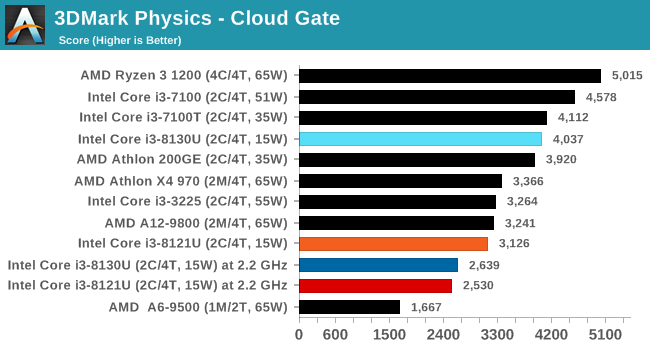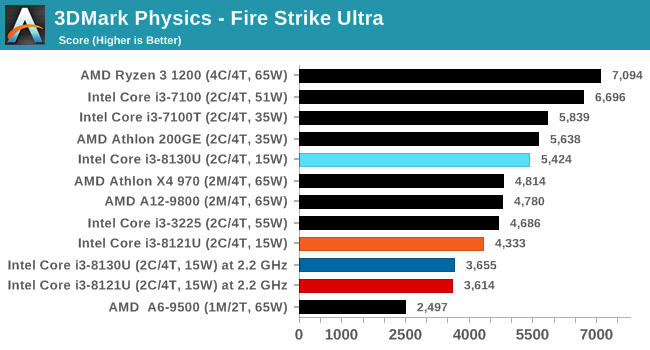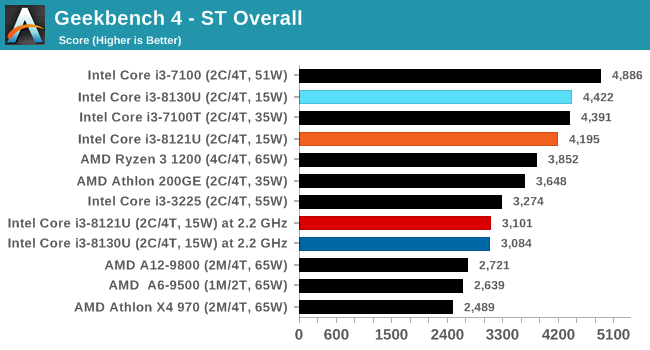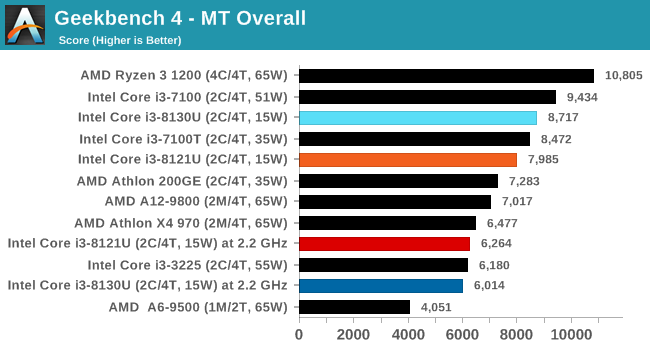Intel's 10nm Cannon Lake and Core i3-8121U Deep Dive Review
by Ian Cutress on January 25, 2019 10:30 AM ESTStock CPU Performance: Office Tests
The Office test suite is designed to focus around more industry standard tests that focus on office workflows, system meetings, some synthetics, but we also bundle compiler performance in with this section. For users that have to evaluate hardware in general, these are usually the benchmarks that most consider.
All of our benchmark results can also be found in our benchmark engine, Bench.
3DMark Physics: In-Game Physics Compute
Alongside PCMark is 3DMark, Futuremark’s (UL’s) gaming test suite. Each gaming tests consists of one or two GPU heavy scenes, along with a physics test that is indicative of when the test was written and the platform it is aimed at. The main overriding tests, in order of complexity, are Ice Storm, Cloud Gate, Sky Diver, Fire Strike, and Time Spy.
Some of the subtests offer variants, such as Ice Storm Unlimited, which is aimed at mobile platforms with an off-screen rendering, or Fire Strike Ultra which is aimed at high-end 4K systems with lots of the added features turned on. Time Spy also currently has an AVX-512 mode (which we may be using in the future).
For our tests, we report in Bench the results from every physics test, but for the sake of the review we keep it to the most demanding of each scene: Ice Storm Unlimited, Cloud Gate, Sky Diver, Fire Strike Ultra, and Time Spy.





In all tests, at fixed frequency, the processors act identical, however at stock frequencies that Kaby Lake chip just has more headroom to push.
GeekBench4: Synthetics
A common tool for cross-platform testing between mobile, PC, and Mac, GeekBench 4 is an ultimate exercise in synthetic testing across a range of algorithms looking for peak throughput. Tests include encryption, compression, fast Fourier transform, memory operations, n-body physics, matrix operations, histogram manipulation, and HTML parsing.
I’m including this test due to popular demand, although the results do come across as overly synthetic, and a lot of users often put a lot of weight behind the test due to the fact that it is compiled across different platforms (although with different compilers).
We record the main subtest scores (Crypto, Integer, Floating Point, Memory) in our benchmark database, but for the review we post the overall single and multi-threaded results.












129 Comments
View All Comments
Gondalf - Friday, January 25, 2019 - link
For now they have nothing out in cpu departement, so i don't see any AMD bright year in front of us.I remember you we are already in 2019.
vegajf51 - Friday, January 25, 2019 - link
Icelake Desktop 3q 2020, intel will have another 14nm refresh before then.HStewart - Saturday, January 26, 2019 - link
Intel is expected to release 10nm+ with Covey Lake by Christmas seasons. This canon lake chip is just a test chip.pugster - Friday, January 25, 2019 - link
Thanks for the review. While the performance is not great, what about the power consumption compared with the 8130U?Yorgos - Friday, January 25, 2019 - link
it's not great obviously when you are stuck at 2.2GHz, while the prev gen cpu with the same capabilities(except the avx) can go up to 3.4GHz.I bet the 8130 would've been faster even if configured at 10Watt TDP.
Yorgos - Friday, January 25, 2019 - link
...and before jumping on me about that "stuck at 2.2GHz" let me report this:in certain loads the locked freq is slower than the unlocked one.
What does this mean? it most probably means that the unlocked freq makes the cpu run hot, throttle and then try to balance between temperature and consumption.
and a subnote on this. I think Intel should stop pushing the AVX instructions. It doesn't work as intended, it's not needed in most cases, especially when you have to design 256bit buses for 512bit data transfer on a low power cpu. Also it takes a lot of space on the die, it taxes the cache buses and it's useless when you disable your igpu(which is a good SIMD machine but not hUMA) and you have a dGPU up all the time just rendering your desktop.
They should try focusing on HSA/hUMA on their cpus+igpus instead of integrating wide SIMD instructions inside their cores.
0ldman79 - Saturday, January 26, 2019 - link
Thing is when AVX2 and AVX512 are used the performance increase can be rather massive.PCSX2, PS2 emulator, runs identically between my 3.9GHz Ivy Bridge Xeon (AVX) and my 2.8GHz i5 Skylake mobile (AVX2).
AVX2 makes several games playable. You can choose your plugin and the AVX plugin cannot play Gran Turismo 4 @ 2.8GHz, the AVX2 plugin can.
You may not find it useful, others do.
HStewart - Saturday, January 26, 2019 - link
It would be interesting to see the emulator re-factor to work with AVX 512 - it would like be twice the speed of AVX 2levizx - Sunday, January 27, 2019 - link
Nope, even with the simplest data set where AVX512 can perform twice the speed of AVX2 per cycle, the frequency has to drop significantly (~30% on Xeon Gold 5120 for example), so the upper limit is more like 40% gain. And that's PURE AVX512 code, you won't get that in real life. Assuming 50% AVX2 and 50% AVX512 code - that's a very generous assumption for non-datacentre usage, you'll have a 5% net gain.levizx - Sunday, January 27, 2019 - link
5%~20% net gain, depending on how the scaling works.